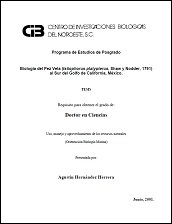Influencia de la proporción sexual y del ambiente en la tasa de crecimiento poblacional de Callinectes bellicosus (Decapoda: Portunidae) del Golfo de California
Sex ratio and environmental influence on population growth rate of Callinectes bellicosus (Decapoda: Portunidae) in the Gulf of California
Autor
DEMETRIO RODRIGUEZ FELIX
MIGUEL ANGEL CISNEROS MATA
EUGENIO ALBERTO ARAGON NORIEGA
JOSE ALFREDO ARREOLA LIZARRAGA
Metadatos
Mostrar el registro completo del ítemResumen
"Sex ratio and environmental influence on population growth rate of Callinectes bellicosus (Decapoda: Portunidae) in the Gulf of California. The brown swimming crab (Callinectes bellicosus) is an economically important species in the Gulf of California, and its fishing activity, held in Sonora from 1986, has been affected by a 20-year declining trend in its biomass. With the aim to understand the possible reasons of this species population changes along time, we estimated population growth rate (r) and sex ratio of C. bellicosus, and combined them with three parameters describing its habitat: sea temperature, wetland extension and habitat size in four areas along the coast of Sonora. For this, monthly mean sex ratio was estimated from crabs samples obtained from commercial catches during 1998-2002 and 2012; mean sea surface temperature for the spawn¬ing period (May-August) were derived from remote sensors for the same years; while wetland coverages were obtained from published reports, and habitat size was estimated as the fishing surface. For each area, r was esti¬mated using a method developed for limited data situations using commercial landings (t) from 1986-2013. With data from the four areas, simple and multiple linear regression models were developed to ascertain theoretical sensitivities of r to variations in sex ratio and environmental parameters. A total of 24 556 crabs were sampled; males dominated (68.8 %) over females during the study period and in all areas; a cluster analysis identified two groups according to sex ratio: a Northern group with zones 1 and 2, and a Southern group with zones 3 and 4. r values were different in all zones (P<0.001) as was sex ratio (P=0.037); no differences in temperature were iden¬tified within the study years (P>0.995). Both the estimated data and sensitivity analyses suggest the existence of a direct and positive dependence of r on the proportion of female crabs and wetland size. We hypothesize that excess fishing of females caused the declining biomass trend of the brown swimming crab in Sonora, and concluded on the convenience of implementing harvest refugia inside coastal wetlands to protect females during the spawning season."
Colecciones
Ítems relacionados
Mostrando ítems relacionados por Título, autor o materia.
-
PROMOCIÓN DEL PERIFITON PARA EL CULTIVO DE CAMARÓN BLANCO: HACIA UNA ACUICULTURA ECOLÓGICA
DOMENICO VOLTOLINA LOBINA; JUAN MANUEL AUDELO NARANJO; MARIA DEL ROSARIO PACHECO MARGES -
Suelo y Erosión
YOLANDA LOURDES MAYA DELGADO


